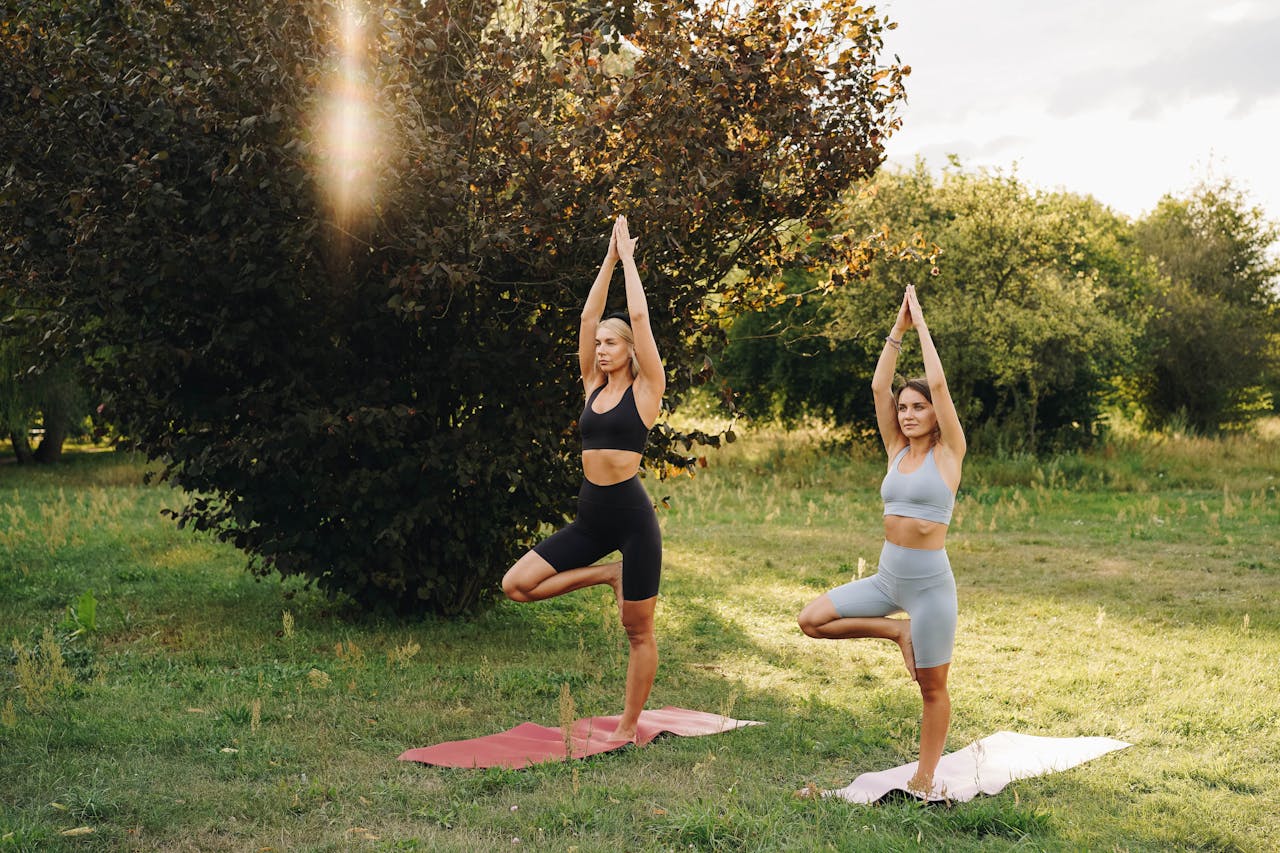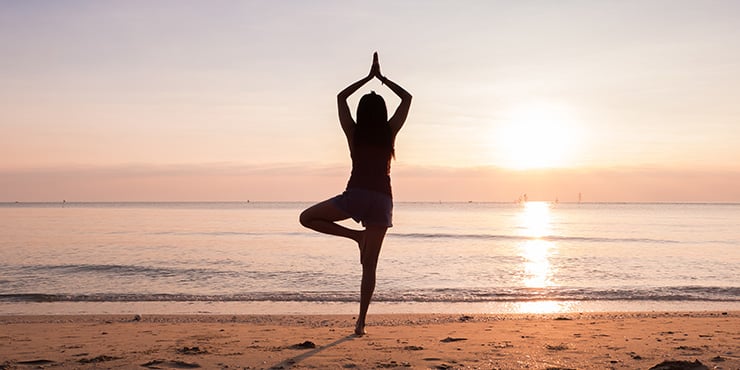
Table of Contents
Vrikshasana, or Tree Pose, is a standing and balancing pose in which the practitioner stands on one leg with the lift foot placed against its inner edge. The knee of the lifted leg should point outwards. Hands can be in a prayer position in front of the chest or extended over the head.
Sanskrit Meaning
Vrikshasana comes from the Sanskrit word “Vriksha,” meaning tree. The practice of standing on one leg and extending the arms outwards, like branches of a tree, reflects this.
The Benefits of Vrikshasana
Standing balancing poses like the vrikshasana tree pose has profound benefits for yoga practitioners. Some of these benefits include:
- Improves balance: By lengthening the spine and balancing on one leg, this yoga pose supports one’s stability and overall poise.
- Strengthens the lower body: The pose helps strengthen the leg muscles, including the inner thighs, hamstrings, and hips. The posture can also aid in strengthening the knee joint by activating the lifted leg.
- Increases flexibility: As a hip opener pose, practicing one’s hip opening capacity while engaged helps improve hip joint flexibility.
Vrikshasana helps open the Root chakra by grounding the foot into the ground, improving the stability and foundation of life.
At the same time, it activates the Third Eye chakra by standing tall and gazing forward, supporting one’s perception and awareness.
Contraindications of Vrikshasana
While the Tree pose has many benefits, it is not for everyone and puts those with injuries in a vulnerable position.
Those with knee injuries, hip injury, back pain, or ankle sprains should avoid this pose. People with high blood pressure should practice Vriksana with caution.
If the practitioner is pregnant, they should consult a doctor before practicing this yoga pose. People who suffer from vertigo should not attempt to do this pose.
Make sure to take your time and have a qualified instructor guide you through the posture.
Variations of the Tree Pose (Vrikhsasana)
In the standard version of vriksasana, the lifted foot is as close to the pelvis as possible. Beginners may find it easier to practice Tree Pose with the foot lower on the inner thigh or even against the inside edge of the shin.
An alternate approach for those just starting out is to stand with the lifted leg turned out, knee bent up, and foot lifted without touching the standing leg thigh. When using this variation, one can work on raising the knee as high as possible out to the side while keeping it bent or dropping down and bringing their foot as close as possible to their inner thigh while maintaining a knee bend.
Though tree pose generally uses a straight leg, a slight external rotation with toes pointing to the corner of the room may be helpful for some beginners.
Introduction to Vriksasana: A Beginner's Guide
Beginner tree pose practitioners can follow these step-by-step instructions:
- Start by standing straight, with the legs together and facing forward. Lengthen the front body by maintaining a strong core and pressing the shoulders down.
- Engage the core muscles and shift the entire body weight onto the left foot. Bend and lift the right leg off the ground and hold it lightly against the heart center. Actively press the right hip down, so it is in line with the left hip.
- Place the right foot firmly against the left thigh or calf, depending on the practitioner’s flexibility. Ground the left leg by feeling the four corners pressing into the ground and keeping a straight leg.
- Join the palms together in front of the chest in Anjali Mudra (prayer position). Simultaneously lift both shoulder blades while drawing them slightly rearward as if trying to tuck them under each armpit.
- Directing the gaze to one point for better balance will help posture stability. One may lift their arms overhead while taking the upper arms away from the ears.
- Reach tall and stay active, holding this posture for 30 seconds to a minute.
- Lower the arms, separate the palms and return to the standing pose.
- Repeat on the other leg.
Preparatory Poses for Vrikshasana
Two common yoga poses that prepare yoga practitioners for tree pose include:
Preparatory pose one
Lift one knee in front of the chest and then out to the side, hugging it in with both hands while keeping the upper body straight and pelvis level. When lifting the knee to the side, release one arm and use the other to hug the right knee against the body.
Preparatory pose two
Practitioners can lean their glutes against the wall or turn so that their lifted knee comes in contact with the wall.
Exercising and Anchoring The Hip Flexors for Vrikshasana
To make it easier to keep a leg up in Tree pose, practice lifting the knee in front of the body (with the knee bent) and then externally rotate the hip while bending the knee.
To help anchor the hip flexor muscles that attach to these points on the hip bone, focus on doing an upward pull on the end of the hip bone on the raised leg side by lifting the chest and keeping an active core.
Enhancing Balance Through Weight Shifting
To make balancing on one foot easier, one can shift their weight forwards so that the toes and forefoot press down. To practice this, stand in a variation of Mountain pose with feet hip-width apart, then shift forward and back to feel the toes pressing down and relaxing, respectively. Repeat while standing on the other foot.
Maintaining Balance on One Foot

It is essential to keep the body weight directed forward, towards the big toe. To facilitate this, remain aware of the standing foot while attempting to maintain balance.
If the practitioner feels their weight shifting back, they can counter that tendency by shifting it forward. One will know that their weight is shifting back when they feel a reduction in the pressure in their toes.
Keep the supporting foot muscles engaged and maintain proper alignment while performing the posture. Spread through the toes and press the foot firmly into the floor while making small movements that help maintain balance.
Try to stay relaxed and focus on maintaining an even breath.
Enhancing Balance Through Stabilizing the Standing Leg
Maintaining balance on one leg necessitates stabilizing that leg's foot, knee, and hip. One approach is to focus on stabilizing the hip before moving downwards towards the foot. Alternatively, one could stabilize the foot and ankle first before working up.
Controlling rotation at these joints can be vital for maintaining balance. For example, in Tree Pose, pressing the foot against the inner thigh can affect rotational control of the standing leg; it may be better to press slowly against it.
Positioning the Lifted Leg For Balance
To get the lifted foot position against the inner thigh of the standing leg, it is generally necessary to lean forward and grip the shin with a hand. As one straightens upright and lifts the leg higher, they should be mindful of continuing to press their toes into the floor or ground so that their weight remains directed forward.
When pressing the foot against the inner thigh, hold the lower leg firmly with the hand and gradually increase pressure. To make balancing easier, try exerting the inner thigh against this pressure simultaneously.
Enhancing Balance Using a Towel or Strap
By looping a towel or strap around the shin of the lifted leg, users can increase their reach, making it more straightforward to stay upright while utilizing their hand to lift the leg up.
As soon as the foot is in position, release the strap; unless the practitioner is wearing clothing with low friction, in which case, continue holding onto it to stay balanced.
Challenging Traditional Tree Pose
Try Tree pose standing on an uneven surface such as a folded blanket or folded mat – this will challenge the practitioner’s balance and strengthen small muscles in the feet.
One can explore a bound tree pose by incorporating other poses, such as bringing their right foot into a Half Lotus position, wrapping the right arm behind them, and hooking the big toe with the thumb and forefingers. From here, practitioners can fold forward into Ardha Baddha Padmottanasana (Half Bound Lotus Standing Forward Bend).
References
Get to Know the 8 Limbs of Yoga
What Is Yoga Nidra? – Cleveland Clinic.
How to do Vinyasa Flow | ClassPass.
Ashtanga Yoga IS Hard—A Beginner's Guide to How to Practice – OmStars.
Iyengar 201: The Strap Trick You Need to Try to Release Your Neck Tension
Intro to Chanting, Mantra, and Japa
What is Om Namah Shivaya? - Definition from Yogapedia
What is Shabda Brahman? - Definition from Yogapedia
Disclaimer
The contents of this article are provided for informational purposes only and are not intended to substitute for professional medical advice, diagnosis, or treatment. It is always recommended to consult with a qualified healthcare provider before making any health-related changes or if you have any questions or concerns about your health. Anahana is not liable for any errors, omissions, or consequences that may occur from using the information provided.

By: Anahana
The Anahana team of researchers, writers, topic experts, and computer scientists come together worldwide to create educational and practical wellbeing articles, courses, and technology. Experienced professionals in mental and physical health, meditation, yoga, pilates, and many other fields collaborate to make complex topics easy to understand. Anahana is also home to specialists in crystals, tarot, angel numbers, astrology, life path numbers, zodiac signs, and horoscopes. By combining evidence-based wellness with spiritual and energetic practices, the team offers clear, trustworthy guidance for both mind-body health and modern spirituality.